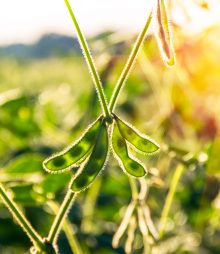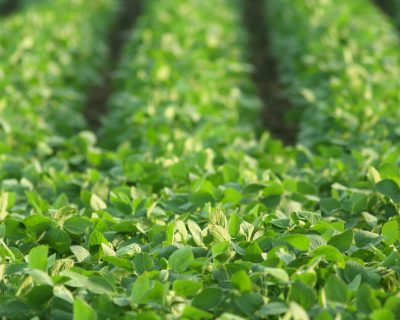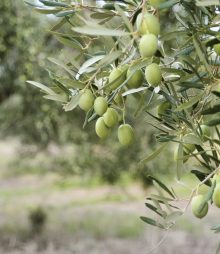Our firm uses a large number of different raw materials to make our recipes. However, certain vegetable oils almost always enter into the composition of our various products. Why use certain oils in particular, rather than others, and how are they produced?
Palm oil

Annual production
68 million tonnes
Harvest period
All year round (maximal yield of the palm trees between August and November)
Advantages
Stable, easy to cultivate, neutral nutritional profile, very large range of applications
Yield
3 to 6 T/ha
Production method
Hot pressing of the pulp of the palm fruit
.Disadvantages
Industrialisation of its culture, deforestation
Main growing areas

L’huile de palme
Indonesia, Malaysia, Africa, South America
Palm oil is a necessary ingredient in our trade. Necessary and even irreplaceable. Because, contrary to popular belief, it is a relatively balanced product… but to explain why, it is important to start from the beginning.
Originally, and into the 90s, margarines were produced using animal fat, mainly beef and lard (pork fat). These materials gave the margarine its solid structure. In the wake of the “mad cow” crisis, followed more recently by the dioxin crisis, animal fats were eliminated from the manufacture of margarine, as they were associated with a food risk in the minds of many customers. Moreover, the rather strong taste of these animal fats were sometimes considered unsavoury.
To find the best replacement for these animal fats that had fallen out of favour, “hydrogenated” vegetable fats emerged. In simple terms, these are liquid vegetable oils (from rapeseed, sunflower, soy, etc.) that are artificially solidified by heating and adding hydrogen. Adding hydrogen stiffens the fatty acid chain of the oil and thus gives a solid texture at room temperature.
The problem: thanks to advances in science and the ever greater subtlety of the analyses, we realised about 25 years ago that the so-called “partial” hydrogenation technique, used at the time by all refiners, had the undesirable side effect of generating trans fatty acids in the fat. And in some raw materials, such as partially hydrogenated peanut oil, these levels of trans fatty acid is very high. In short, trans fats are unsaturated fats (but still solid) that are particularly harmful. When consumed in large quantities, they can lead to cardiovascular disease and certain cancers.
Faced with this problem, the refiners (our suppliers) obviously could not rest on their laurels: hydrogenated fat production evolved into the so-called “total” hydrogenation technique. The process is longer than “partial” hydrogenation and does not generate trans fatty acids. But most people still associate the term “hydrogenation” with “trans fats” and therefore a health hazard… wrongly. Even today, most requests we receive almost exclusively concern products without “hydro”.
But to make a margarine, a significant part of fat that is solid at room temperature is necessary to obtain the basic structure of the product. This makes it impossible for us to work exclusively with rapeseed, soya, olive or sunflower oils, as all these oils are… liquid. Without being able to make use of animal fats or hydrogenated fats, nature therefore only has few options to offer us. The main 3 are coconut oil, shea butter… and palm oil.
Of these three options, and even every other option imaginable, palm oil is the only one that really makes sense. First of all, from an environmental and social perspective: the yield of oil palm is quite simply exceptional because this plant produces fruit throughout the year. Substituting it with any other plant will inevitably take up far more agricultural land to obtain an equivalent volume of production, running the risk of exacerbating the environmental and social problems.
Secondly, from a nutritional point of view: while palm oil is criticised for containing 50% of saturated fat, which is associated with cardiovascular problems, coconut fat contains +/- 90% and shea butter about 45%. Even dairy butter, which nevertheless enjoys excellent press coverage in our part of the world, naturally contains about 67% saturated fat, cholesterol, and between 3 and 5% of trans fatty acids generated by the cow’s digestion. It isn’t therefore a matter of choice or prices: there is simply no credible alternative to replace palm oil at the current point in time.
This obviously does not mean either that this oil is miraculous and should be consumed without moderation, as a replacement for any other oil or fat. It remains a fat that has its qualities and its defects. For example it is very resistant to oxidation and can therefore be stored for a long time. It is also extremely resistant to high temperature cooking and is therefore frequently found in frying fats. It is devoid of any trans fatty acid in its natural state. And it gives a soft and creamy character in many applications.
However, it has a 50% saturated fat content, which is much higher than most liquid vegetable oils. In addition, its cultivation has become very intensive in Indonesia and Malaysia, as this oil provides a livelihood for local farmers and is now at the centre of much broader economic interests. The problem of deforestation is very real and we take this very seriously at Aigremont. But we believe that the regulation of farming methods, through a strict certification system, is a much more realistic and appropriate response than the empty statements made by some, notably through the labels “No Palm” that are increasingly found on numerous products. As such, ensuring a sustainable and controlled supply is one of our top priorities.
Rapeseed oil

Annual production
25 million tonnes
Harvest period
Between July and August in Europe, between September and October in Canada
Advantages
Rich in omega 3, various applications, very positive nutritional profile
Yield
0,5 to 0,7 T/ha
Production method
Crushing of the seeds (harvesting, storage and pressing)
.Disadvantages
The virgin oil has a strong taste, low yields, a rapid deterioration rate and a strong smell when fried
Main growing areas

L'huile de colza
Russia, Ukraine, Europe, Canada, Australia
Rapeseed oil is widely used in Europe and it is not uncommon to come across rape fields in our countryside. This oil is also frequently used in margarines and fats.
Indeed, it has very interesting nutritional qualities: quite low saturated fat levels, about 7%, and a ratio of Omega 6 to Omega 3 of around 2-3. The consumption of this oil is therefore often recommended because it helps to rebalance our food, often too rich in saturated fats and Omega 6 that are “pro-inflammatory” for our bodies.
However, it does have a rather strong taste, with a rancid character, and it is not always appreciated by many. This is why it rarely features in everyday recipes.
However, it is widely used in our margarines and is one of our main ingredients. Its incorporation into many of our recipes makes it possible to give our margarines and fats a more balanced nutritional profile. However, its liquid character at room temperature means that its inclusion in our products is limited, otherwise they would become too soft and unusable.
Sunflower oil

Annual production
15 million tonnes
Harvest period
Between September and November in Russia and Ukraine, between March and May in Argentina
Advantages
“Nutty” taste, various applications
Yield
0,4 to 0,6 T/ha
Production method
Crushing of the seeds, then pressing
.Disadvantages
Too rich in Omega 6, low yields, rapid deterioration when fried
Main growing areas

L'huile de tournesol
Russia, Ukraine, Argentina
Sunflower oil, like rapeseed oil, is widely used in Europe. It is also present in the composition of many margarines and fat.
It is also often used in its oily state, for seasoning or frying. Its “multi-purpose” nature means it can be used in many applications.
Its taste is pleasant, allowing its use “cold”, for example in salad dressings. This oil is sometimes incorporated into margarines, mostly for spreading because its taste usually brings a touch of freshness to the product.
Its taste also resists quite well to high cooking temperatures, which explains why it is often found in frying oils. However, when it has been repeatedly heated to high temperatures, sunflower oil tends to deteriorate rapidly and polymerise, forming compounds that are harmful for the body. It is therefore a little less resistant than palm oil in this area. Nevertheless, it contains less saturated fat than palm oil, about 10%, and is rich in vitamin E. To partially overcome this frying resistance problem, a specific variety called “high oleic sunflower oil” has been developed: the taste is much more neutral, but its high temperature degradation is much slower however.
The rate of Omega 6 in refined sunflower oil is however too high. This imbalance between Omega 6 and Omega 3 for that matter requires some moderation to be exercised in its consumption. In fact, our food intake is already too rich in Omega 6, considered as pro-inflammatory for the body. To circumvent this problem, there is a variant, the so-called “oleic” sunflower oil, which was developed in France and whose nutritional characteristics are more similar to olive oil. But its availability is much lower and its price is inevitably higher.
Coconut oil (copra)

Annual production
3,5 million tonnes
Harvest period
All year (maximum yield of the palm trees between August and November)
Advantages
Resists oxidation, vertical melting curve
Yield
0,4 to 0,6 T/ha
Production method
Drying and pressing of the chopped coconut
Disadvantages
Rich in saturated fats, sensitive to saponification
Main growing areas

L’huile de coco (coprah)
Indonesia, Philippines, India
Coconut oil (or copra) is particularly rich in saturated fat, with a rate of over 90%. It has properties that are very similar to palm kernel oil, its main substitute, and its applications are very close.
The high levels of saturated fats makes this fat solid at room temperature, but its melting curve is very vertical: in other words, this fat goes very quickly from a solid state, which is maintained until about 20°C, to a liquid state, beyond 25-30°C.
Copra is used extensively in ice cream and chocolate applications. The speed of this transition between solid and liquid states indeed avoids the fatty impression in the mouth in the finished product. The unpleasant after taste in the month is in fact generated when a fat melts too slowly or only starts to melt at above 37 degrees, the temperature of the body and therefore of the mouth, and starts to line the palate.
The copra is also used for frying, especially in Asia, and even in some pastries. However, coconut oil is very sensitive to the phenomenon of saponification and therefore often any contact with any trigger, such as flour, is avoided for example. A small proportion of saponified coconut is indeed enough to make the product unfit for consumption, giving it a pronounced taste of soap. Conversely, copra is obviously extensively used in the field of cosmetics and soap.
Its production is heavily concentrated in the Philippines and Indonesia and is still largely unmechanised, generating relatively low yields. Although this fat may therefore seem rather well known to the public in Europe because it is associated with its flesh, which we consume quite regularly, availability remains rather low. This explains why palm oil is often preferred.
Soya oil

Annual production
60 million tonnes
Harvesting period
Between March and June in the Southern hemisphere, between September and October in the Northern hemisphere
Advantages
Source of omega 3, varied applications, positive nutritional profile
Yield
0,3 to 0,6 T/ha
Production method
Crushing of the seeds (harvesting, storage and pressing)
Disadvantages
GMO cultivation in some areas, very low yields, deforestation in South America
Main growing areas

L'huile de soja
Brazil, Argentina, USA, China, India
Soya oil is one of the most common vegetable oils in the world. It is grown in many countries and is the oil most consumed in the US.
It can be used in cooking but is less suitable for frying, as the oil rapidly degrades when temperatures exceed 150°C. The cakes, residues from the pressing of the seeds to extract the oil, are also reused, especially in the field of animal feed.
Its nutritional profile is quite interesting, with a ratio of Omega 6 to Omega 3 of around 7 to 9, just over the ratio of 5 generally considered as ideal. Its cultivation is however often associated with the notion of GMOs and of deforestation in the Amazon.
At our level of production, we do not use soya oil anymore, as we prefer more local distribution networks, such as rapeseed and sunflower oils. Nevertheless it is found often in margarines made in the USA.


Palm kernel oil

Annual production
5 million tonnes
Harvest period
All year (maximum yield of the palm trees between August and November)
Advantages
Resists oxidation, easy to grow, vertical melting curve
Yield
0,4 to 0,6 T/ha
Production method
Drying and pressing of palm seeds
.Disadvantages
Rich in saturated fats, industrialisation of cultures, deforestation
Main growing areas

L’huile de palmiste
Indonesia, Malaysia, Africa, South America
Palm kernel oil is actually a “by-product” of the palm oil. While palm oil comes from the fruit pulp, palm kernel oil is extracted by pressing the core of the same fruit.
It contains about 80% saturated fat. This high level of saturated fat naturally makes the product solid at room temperature but its melting curve is nevertheless quite vertical, a temperature above 30°C is sufficient to trigger the melting of the fat.
Palm kernel oil is mainly used to make ice cream or chocolate, where the rapid melting of the product avoids the impression of a greasy taste in the mouth during consumption. However we find also palm kernel oil in many food applications. The main substitute for palm kernel oil is coconut oil (copra) whose characteristics are very similar. This means that the prices of these two commodities are often interconnected.
As palm kernel oil comes from exactly the same regions as palm oil, it obviously raises the same environmental questions. Nevertheless, sustainable supply chains are also being put in place, following the lead of palm oil.
Olive oil

Annual production
3 million tonnes
Harvest period
Between October and November
.Advantages
Pleasant taste, positive nutritional profile
Yield
0,2 to 0,3 T/ha
Production method
Pressing of the fruit and juice extraction (liquid/solid) and settling (oil/water)
Disadvantages
Insufficient production, low yield, high variability in quality levels
Main growing areas

L'huile d'olive
Mediterranean basin
Olive oil is often considered the queen of vegetable oils. Or let’s say of a variety of oils because, between virgin olive oils and refined oils, there are many different levels of quality. It is also an oil for which there are numerous designations of origin.
From a nutritional standpoint, it still contains on average 15% of saturated fat and has a ratio of Omega 6 to Omega 3 of around 12, which is slightly high but yet not prohibitively so. However, the nominal quantities of Omega 3 and Omega 6 found in olive oil are rather low, which greatly reduces the value of this oil at this level.
However, it is rich in vitamins A and E. It resists quite well to high cooking temperatures and can therefore be used for frying. It is also sometimes incorporated into some solid fats, adding its flavours to the mix.
As the main asset of olive oil is its very particular taste, almost indissociable from Mediterranean cuisine. It is most often used as a seasoning or for cooking.